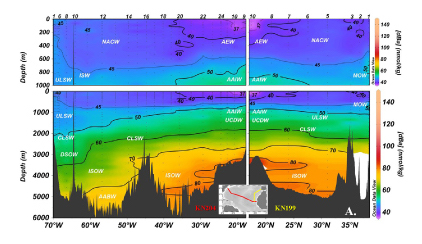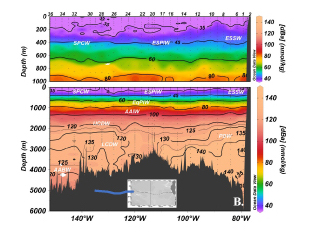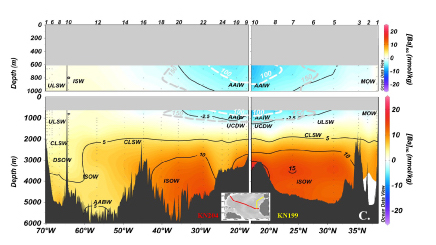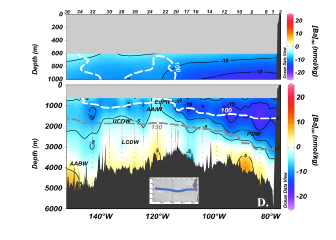High resolution of dissolved and particulate barium distributions in the Atlantic and Pacific Ocean reveal the importance of the margin sources on the oceanic barium budget
Rahman and co-workers (2022, see reference below) performed intensive samplings and analyses of dissolved (dBa) and particulate (pBa) barium along the GEOTRACES GA03 North Atlantic and GP16 Eastern Tropical Pacific transects. Water mass mixing models allowed them to establish that most of the dBa variations are controlled by water mass mixing (i.e., the preformed or conservative dBa fraction). However, a close study of the non-conservative fractions reveals that nonconservative processes are likely driving 30% of the supply/removal of dBa along both transects. Interestingly, in situ formation of barite in OMZs leads to negative deviations from dBa concentrations predicted from water mass mixing.
It came out from all the calculations that pBaxs (excess particulate Ba, in other words particulate Ba in excess of that predicted from crustal values) dissolution in the water column below the mesopelagic zone may explain inter-ocean variability in [Ba]nc (nonconservative dBa).
The authors also established that the global river dBa delivery (freshwater component) to the ocean is ∼50% lower than previous estimates. Contrastingly, associating radium isotopes to dBa distribution, they revealed that the western continental shelf of the North Atlantic supplies significant net new dBa to the ocean basin. Margin sources have been overlooked so far. This new addition of dBa is equal to or exceeds the combined dissolved plus desorbed particulate Ba global flux from rivers. The consequence of this extensive dBa, pBa and Ba source study is a revision of the dBa oceanic residence time by a factor of ~2.




Figure: Distributions of dBa along (A) GA03 North Atlantic and (B) GP16 Eastern Tropical Pacific transects. Water mass mixing models revealed that ~30% of the supply and removal of dBa was due to nonconservative processes, leading to positive and negative [Ba]nc values along both (C) GA03 and (D) GP16 transects. Dissolution of pBaxs below the mesopelagic zone leads to positive [Ba]nc, whereas pBaxs formation in OMZs lead to negative [Ba]nc values (panels C & D).
Reference:
Rahman, S., Shiller, A. M., Anderson, R. F., Charette, M. A., Hayes, C. T., Gilbert, M., Grissom, K. R., Lam, P. J., Ohnemus, D. C., Pavia, F. J., Twining, B. S., & Vivancos, S. M. (2022). Dissolved and Particulate Barium Distributions Along the US GEOTRACES North Atlantic and East Pacific Zonal Transects (GA03 and GP16): Global Implications for the Marine Barium Cycle. Global Biogeochemical Cycles, 36(6). doi:10.1029/2022gb007330
